Fracking has induced earthquakes in northwest Alberta, some of which have lasted for months due to residual fracking fluid, according to a new study published in Science today.
Scientists collected and analyzed seismic data dating back to the winter of 2015, when the first earthquake larger than a magnitude 4 was recorded in Fox Creek.
Data was compiled from private and public seismograph stations, monitors installed after the earthquake and a comprehensive database of hydraulic fracturing data from each well in the area.
Seismologist David Eaton says some of the earthquakes have been caused by slippage along previously unknown faults deep in the earth.
Others stem from oilsands fluids that can cause long-term pressure changes in underground rock formations. The changes can cause quakes for weeks or months after the fluid injection stops.
Eaton says he believes the findings could change the way fracking is regulated.
“It’s our hope that this work is going to contribute to science informed regulations, so that we can take this knowledge and use it to improve the existing regulations. We’re also hoping that it will improve both risk assessment and mitigation strategies by industry,”Eaton said.
Hydraulic fracturing involves injecting a high-pressure slurry of mainly water and sand into underground formations, creating a network of small cracks or fractures through which oil and natural gas can flow into wells.
Agencies/Canadajournal
 Canada Journal – News of the World Articles and videos to bring you the biggest Canadian news stories from across the country every day
Canada Journal – News of the World Articles and videos to bring you the biggest Canadian news stories from across the country every day



